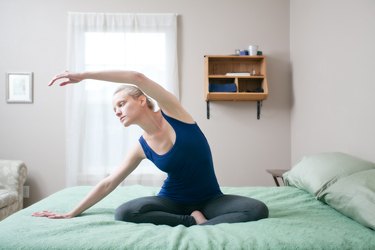
Most people think of stretching as something to do in the morning or before a workout; however stretching before bed has several benefits as well. Here are some nighttime stretches that can help ensure a good night's sleep.
Read more: 6 Morning Stretches to Energize Your Day
Video of the Day
Video of the Day
Benefits of Stretching Before Bed
The National Sleep Foundation says that stretching before you go to bed can help alleviate some of the stress accumulated during the day, by relaxing your muscles and relieving tension. It can be quite difficult to fall asleep when you're tense and stressed out; it's much easier to drift into slumber when your body and mind are calm and peaceful.
Harvard Health Publishing explains that there's a neurochemical connection between exercise and stress. Exercise reduces the levels of the stress hormones cortisol and adrenaline in your body. It also triggers the release of endorphins, which are chemicals in your brain that can boost your mood and act like natural painkillers.
Nighttime stretches may have other benefits as well. A small study published in the March 2012 issue of the Journal of Physiotherapy found that stretching before bed helped decrease the frequency and severity of leg cramps. Another small study, published in the journal Menopause in August 2016, found that 10 minutes of stretching before bed helped reduce menopausal and depressive symptoms in women.
Read more: What Are the Benefits of Good Flexibility?
Try These Nighttime Stretching Exercises
Harvard Health Publishing lists some stretches you can do at night before you go to bed. Try to hold each of the stretches for three to five minutes. You can use pillows, bolsters, blankets or blocks if they help you feel more comfortable and make it easier for you to hold the stretch.
Move #1: Child's Pose (Balasana)
- Sit on your knees with your big toes touching each other and your knees hip-width apart.
- Exhale and bend forward, resting your torso on your thighs and your forehead on the floor.
- You can keep your arms by your sides or stretch them out in front of you with your palms on the floor for a more active stretch.
- Slowly breathe in and out through your nose.
- You can roll your head gently from side to side to help release the tension in your brow.
Move #2: Standing Forward Bend (Uttanasana)
- Stand with your feet hip-width apart.
- Exhaling, bend your torso forward and fold over from your hips.
- You can rest your hands on the floor or grab your shins.
- Slowly breathe in and out through your nose.
- Gently shake your head from side to side to help relax your neck muscles.
- When you're ready to come up, roll your spine upward slowly, to avoid getting lightheaded.
Move #3: Reclining Bound Angle (Supta Baddha Konasana)
- Lie down and bend your knees.
- Bring your feet near your hips and join the soles together, letting your knees relax and spread wide. You can place blocks or cushions below your knees to support your hips.
- Rest your arms on the floor at a 45-degree angle from your body, keeping your palms turned upward towards the ceiling.
Move #4: Legs Up the Wall Pose (Viparita Karani)
- Line up your mat against an empty space on a wall.
- Sit down next to the wall, with one side of your body pressed against it.
- Lie down on the mat and place both your legs up the wall.
- Keep your arms relaxed at your sides.
Move #5: Corpse Pose (Savasana)
- Lie down with your feet hip-width apart, pointing them away from each other and letting them relax.
- Soften your lower back and relax it.
- Rest your arms at your sides, palms facing upward.
- Ensure that your shoulders are not hunched up towards your ears.
- Focus on each part of your body and consciously relax it.
Read more: 11 Stretches Almost Everyone Can Do
- National Sleep Foundation: “Nighttime Exercise Routines”
- Harvard Health Publishing: “Exercising to Relax”
- Journal of Physiotherapy: “Stretching Before Sleep Reduces the Frequency and Severity of Nocturnal Leg Cramps in Older Adults: A Randomised Trial”
- Menopause: “Effects of Stretching on Menopausal and Depressive Symptoms in Middle-Aged Women: A Randomized Controlled Trial”
- Harvard Health Publishing: “Yoga for Better Sleep”